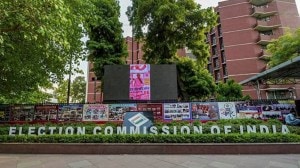- India
- International
To keep the river alive
The Namami Ganga initiative must build on what has been achieved. And go beyond involving organisations of the ruling dispensation’s extended ideological brotherhood.
 A number of other historic and culturally significant rivers across the country, like the Yamuna and the Sutlej, also demand our attention. Source CR Sasikumar
A number of other historic and culturally significant rivers across the country, like the Yamuna and the Sutlej, also demand our attention. Source CR Sasikumar
The Namami Ganga initiative must build on what has been achieved. And go beyond involving organisations of the ruling dispensation’s extended ideological brotherhood.
The finance minister announced the high-profile “Namami Ganga” project in his recent budget speech with an allocation of Rs 2,037 crore, but no other details. But what is really new about it, and is the hype justified? Rajiv Gandhi, in his very first address to the nation as prime minister on January 6, 1985, announced a major programme to clean the Ganga. In February 2009, Manmohan Singh declared the Ganga our national river and announced the establishment of the National Ganga River Basin Authority (NGRBA) under his chairmanship, comprising the chief ministers of Uttarakhand, Uttar Pradesh, Bihar, Jharkhand and West Bengal and well-known activists and professionals. The NGRBA is supported by similar authorities in the basin states, chaired by the respective chief ministers.
The NGRBA was created after a detailed evaluation of the strengths and weaknesses of earlier Ganga action plans (GAP), on which some Rs 900 crore has been spent. They were successful in preventing further deterioration in water quality and, in fact, in improving it in some places, despite ever increasing population and other pressures. The GAPs ensured that dissolved oxygen was largely within acceptable limits. But variation in biochemical oxygen demand values was much higher as compared to dissolved oxygen and faecal coliform counts frequently exceeded stipulated limits, particularly at Kannauj, Kanpur, Allahabad and Varanasi.
Between February 2009 and March 2014, the NGRBA implemented Mission Clean Ganga, whose main objective was to ensure that by 2020, no untreated municipal sewage or industrial effluents would be let into the river. The mission had two anchors — nirmal dhara (clean flow) and aviral dhara (minimum continuous flow). To fulfil both goals, the NGRBA took five far-reaching decisions. First, it sanctioned 81 projects worth Rs 6,400 crore for sewage control and treatment in Uttar Pradesh (Rs 2,700 crore), Bihar (Rs 1,400 crore), West Bengal (Rs 1,200 crore), Uttarakhand (Rs 250 crore) and Jharkhand (Rs 100 crore). This was to create a sewer network of over 3,600 km and a sewage treatment capacity of over 700 million litres per day. A special Rs 500 crore project had been sanctioned for Varanasi alone. Second, it got a consortium of IITs led by IIT-Kanpur to prepare a comprehensive Ganga River Basin Management Plan along with enabling legislation to give effect to the provisions of the plan. Third, it declared the Gangetic Dolphin as the national aquatic animal to make it the symbol of the restoration of the cleanliness of the river. Fourth, notices were issued by the Central Pollution Control Board (CPCB) for the first time to a number of polluting industries, particularly in the critically polluted 730 km stretch from Kannauj to Varanasi so as to signal the government’s firm determination to enforce pollution control standards. Fifth, three hydel projects — Loharinag Pala, Pala Maneri and Bhaironghati — on the upper reaches of the Bhagirathi were abandoned on ecological considerations and the 100 km-long Gaumukh to Uttarkashi stretch declared as a regulated eco-sensitive zone.
Around 70-75 per cent of the pollution in the Ganga is caused by the discharge of untreated municipal sewage from towns and cities along it. That is why the NGRBA gave the highest priority to sewage treatment infrastructure based on future population growth, and had also announced that 70 per cent of the operation and maintenance costs of the infrastructure created would be funded by the Centre. But going beyond sewage control, effluent treatment plants and control of industrial pollution, catchment area treatment, protection of flood plains and preventing run-off of non-biodegradable pesticides from agricultural fields are also equally important activities. An integrated water quality monitoring system will help greatly. The NGRBA had approved of a network comprising 113 automatic stations and another 134 manual stations at critical locations along the main 2,500 km length of the river that would provide state-of-the-art, real-time pictures of water quality through data on 20 critical parameters.

Namami Ganga must go beyond involving organisations belonging to the extended ideological brotherhood of the present ruling dispensation in New Delhi. With elections in UP just two years away, perhaps some partisan politics is at play here. That would be most unfortunate. The initiative must consolidate what has been accomplished so far, since much work has already been done. The IIT consortium, for example, has already submitted 37 reports, and it has given the country the first basin-wide approach to river management, a marked departure from the earlier city-centred approach. Seven hundred and sixty four grossly polluting industries have already been identified and 704 of them have actually been inspected and issued suitable directions. There is always political backlash when such directions are issued, but if we are serious about cleaning the Ganga, then Section 5 of the Environment (Protection) Act, 1986 must be invoked and enforced ruthlessly. For this to be a reality, the five state pollution control boards have to work in tandem with the CPCB. The eco-sensitive zone from Gaumukh to Uttarkashi was finally notified in December 2012 in the teeth of opposition from all political parties in Uttarakhand.
A number of other historic and culturally significant rivers across the country, like the Yamuna and the Sutlej, also demand our attention. The Musi river in Hyderabad and the Mula-Mutha river in Pune, for instance, have become sewers. Work had been initiated as part of the National River Conservation Programme in the ministry of environment and forests, with the Yamuna getting special focus under the Yamuna Action Plan. All these initiatives must now move into higher gear even as Namami Ganga gathers momentum.
The writer, a Congress MP in the Rajya Sabha, was Union minister of environment and forests from May 2009 to July 2011.
40 Years Ago
EXPRESS OPINION
Apr 18: Latest News
- 01
- 02
- 03
- 04
- 05









































